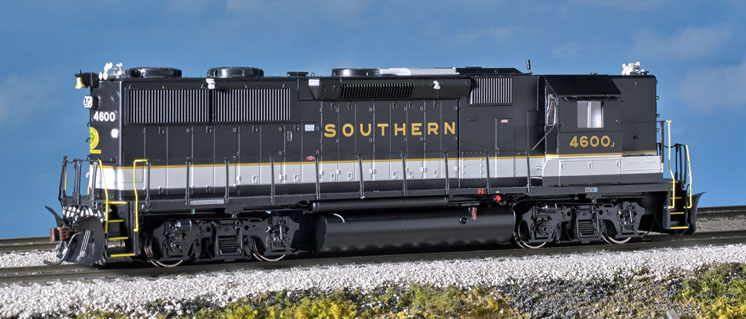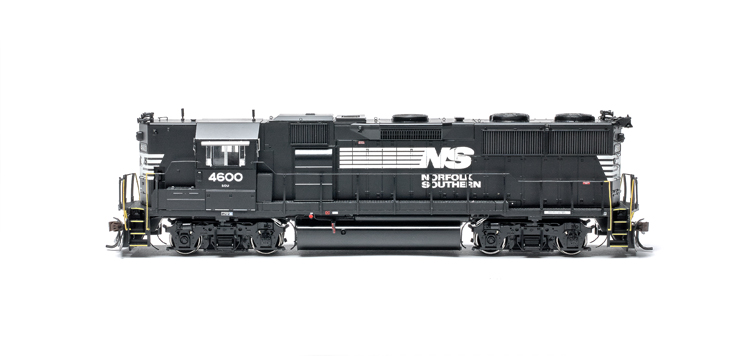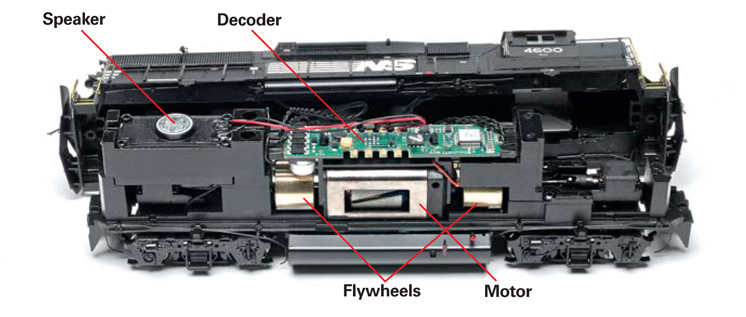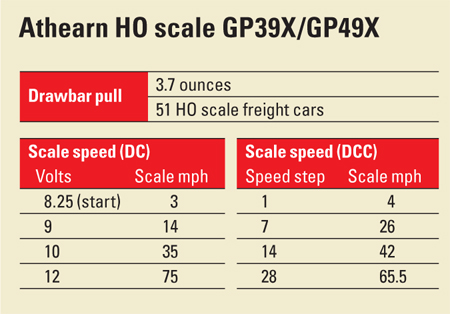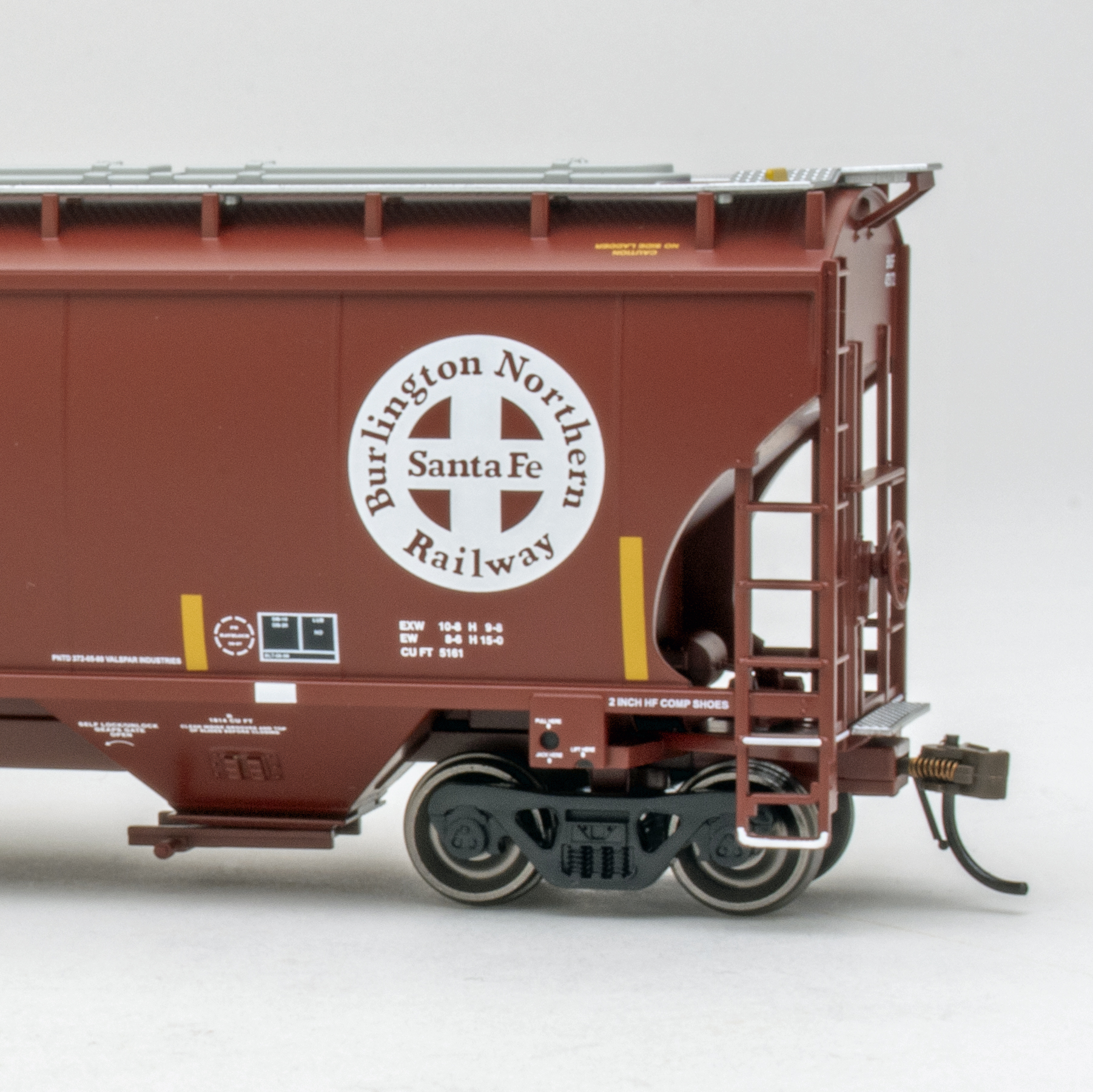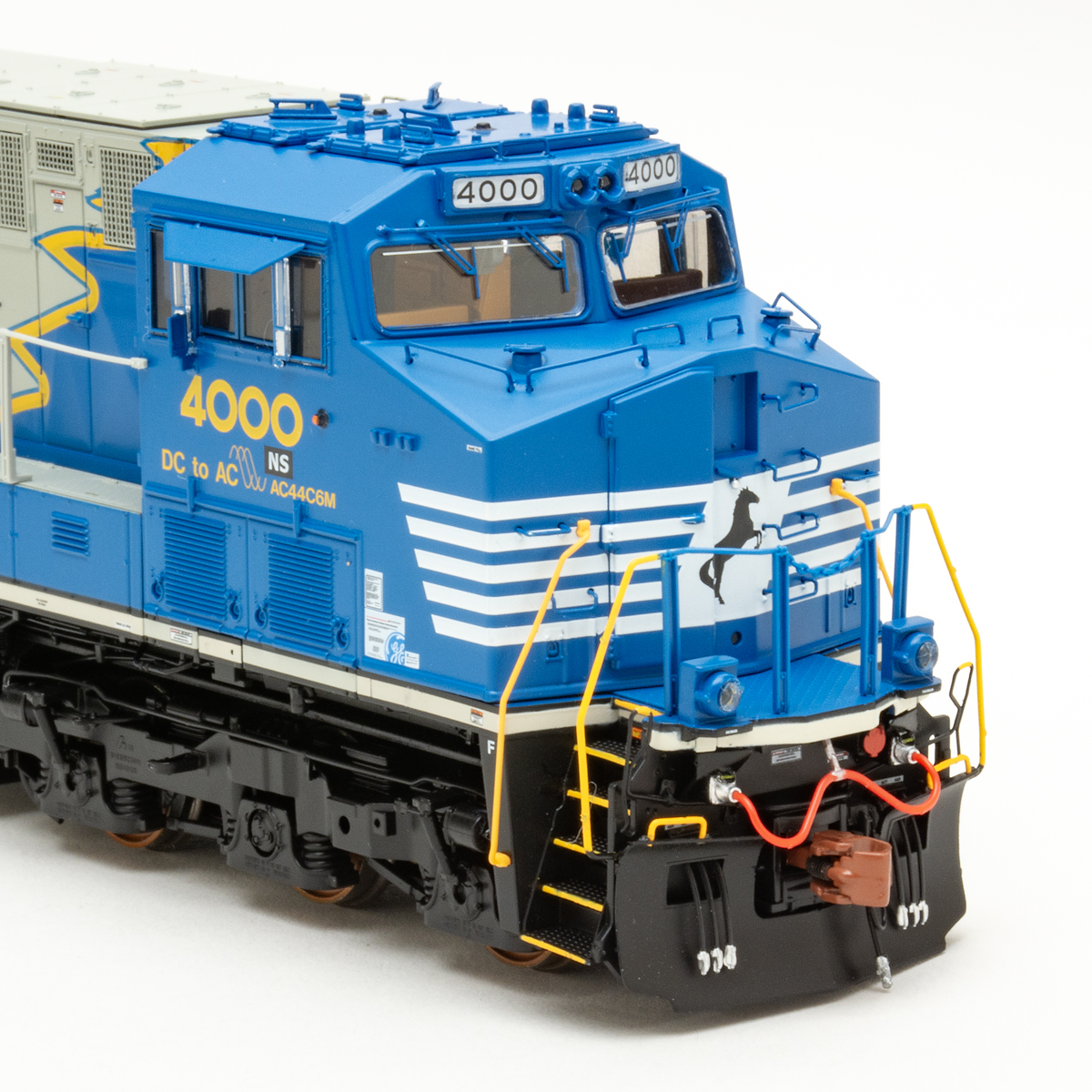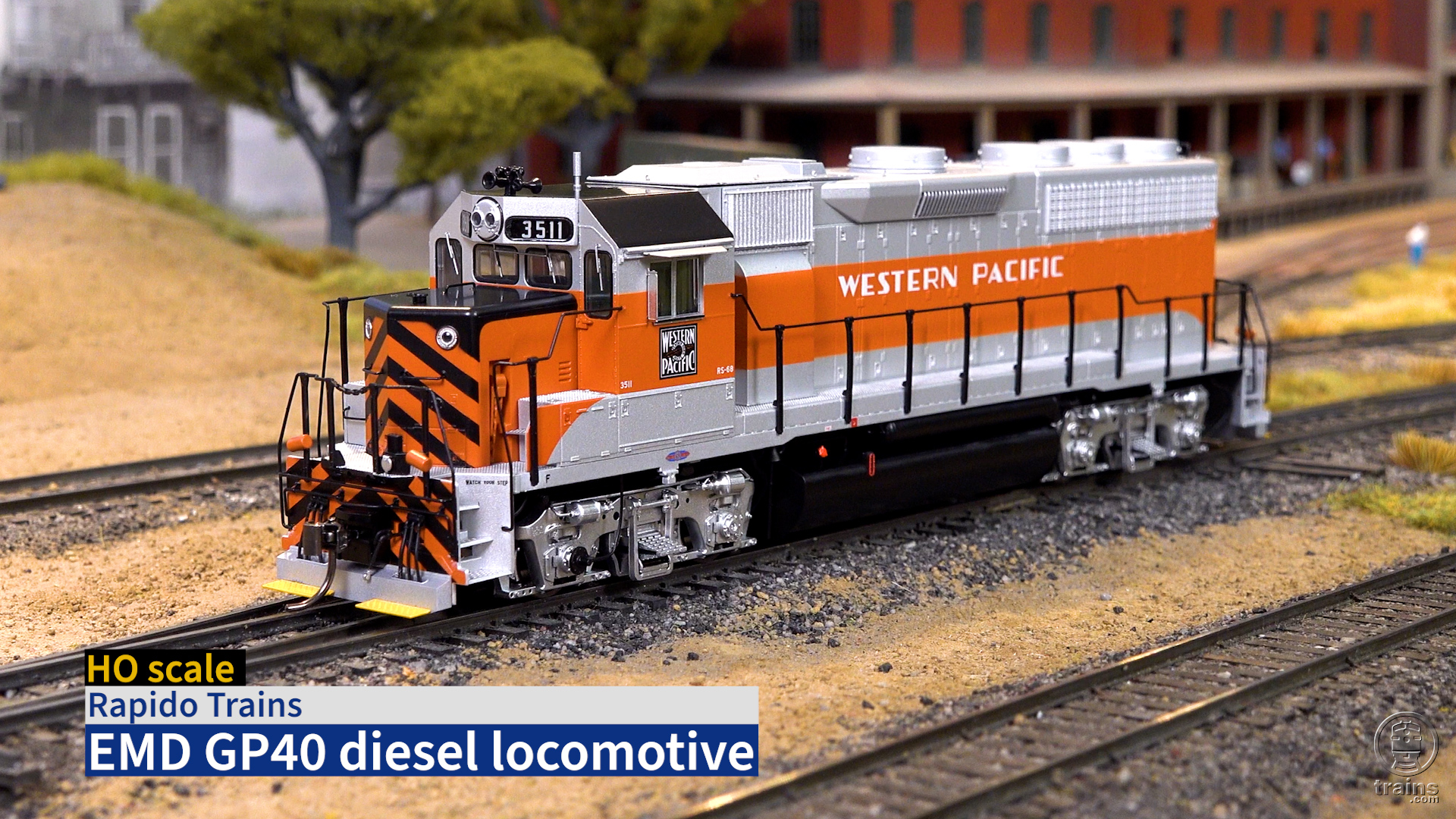Athearn Trains. The GP39X, upgraded to a GP49 after the Southern became part of Norfolk Southern, is available in HO scale equipped with a SoundTraxx Tsunami Digital Command Control (DCC) sound decoder. The models are accurate depictions of the 2,600-hp locomotives first introduced in 1980.
A transitional model. The X in the locomotive’s EMD designation stood for “experimental.” The GP39X was a test bed for new technologies that would become standard with mid-horsepower 50-series locomotives, including a radar-guided anti-wheel-slip system. This system wasn’t popular with engineers, because it dealt with wheel slip by limiting the engine’s acceleration.
The Southern bought six GP39Xs in late 1980, numbering them 4600 to 4605. Like typical Southern diesels, they were equipped with high short hoods and designed to run long-hood forward.
These engines ran on the Southern for only two years before the railroad merged with Norfolk & Western to form NS. The six were sent back to EMD’s LaGrange, Ill., facility, to be upgraded to 2,800 hp, upon which they were redesignated GP49s. Norfolk Southern repainted the engines in its simple black-dip scheme, but kept their road numbers.
The NS ran them until 2001, after which the locomotives were sold to South Florida commuter line Tri-Rail. The new owners had them modified to lower the short hood and add head-end power to run air conditioning on passenger cars. The engines’ pulling power was also downrated to 2,400 hp.
Before and after. Athearn offers the Southern GP39X in all six numbers with DCC and three without, and the Norfolk Southern GP49 in five road numbers (nos. 4600, 4601, and 4605 available with or without DCC, no. 4602 is DC only, no. 4604 is DCC only.)
In addition to the differing paint schemes, there are other slight changes to the model from the SOU to NS eras, including an additional firecracker antenna and a different exhaust silencer. At some point, NS plated over the class lights on the end of the long hood; Athearn’s model doesn’t depict this.
All the body measurements I checked matched dimensions given on an EMD builder’s diagram I found in Kalmbach’s David P. Morgan Memorial Library. The placement of markings and details likewise matched photos of both NS and Southern prototypes I found online.
I did note one discrepancy, though, between Athearn’s model and the Southern prototype. The safety stripes surrounding the step between the two levels of the engineer’s side walkway were, on the model, painted at a gentler angle than those on the prototype. All the diagrams and photos I could find that showed this feature – including the ones in Athearn’s owner manual – depicted the stripes at a 45-degree angle.
On both our samples, the black paint was smooth and even. The Southern model had crisp separation between the black and the gold lettering and striping. On the NS version, though, there were visible voids where the heralds on the long hood crossed panel lines. On both models, tiny printing like the sill- mounted trust plates and the fuel filler label was legible under magnification.
The dynamic brake fan has a finely etched-metal grill, while those atop the radiator fans are molded plastic. The shaped wire handgrabs are scale profile, as are the cab window wipers and the etched-metal lift rings. There are also prototypical, but non-operating, work lights above the walkways.
The flexible plastic handrails were close to scale thickness. However, there were visible shiny patches where some of the stanchions had been glued into the sill. Stanchion or railing mounting pins that hadn’t been glued in place tended to pop out of their holes fairly easily.
A motor with two brass flywheels occupies the center of the frame. The decoder or light board is held on top by two plastic clips. The speaker enclosure sits atop the truck gear tower at the end of the long hood, beneath the radiator fans. On non-sound models, this space carries extra weight for greater traction.
There’s a detailed cab interior, appropriately set up for long-hood-forward running, but no crew figures. The cab’s side windows can slide open. Both sides have etched-metal sunshades, and the engineer’s side has wind deflectors.
The dimmable, directional lights at both ends of the hood are incandescent micro-bulbs, which gives them a pleasing, realistic glow.
Sound decoders take a lot of power, so as I increased the DC voltage, the sound stuttered until it reached 6V. As I cranked up the throttle, the model started moving steadily at just over 8V. At this speed, the bell sounded continuously until I advanced the throttle past 9V. Flipping the direction switch on the power pack while the engine was moving triggered a grade-crossing horn signal. The prime mover sounds, which throttled up and down automatically with the voltage, sounded authentic and strong.
At 12V, the engine topped out at 75 scale mph, pretty close to the 77 mph top speed of the mid-geared prototype.
Under DCC control, the locomotive started moving at 4 scale mph at speed step 1. It topped out at 65 scale mph at speed step 28, slower than the prototype, but perfectly appropriate for an engine heading up a freight train.
The sound decoder comes with 10 built-in horns to choose from. Selecting between them was a simple matter of programming CV115. After trying a few options, I set it back to the Nathan P5 sound that matched the five-chime horns installed on the model’s roof.
The press of function button 4 on a DCC throttle triggers the dynamic brake sound. I was pleased to hear the engine RPMs throttle down to idle while the dynamic brakes were engaged.
After I muted all sounds with a press of F8 on the throttle, the engine’s motor ran smoothly and quietly, with the loudest sound being that of wheels on rails.
Our test-bench force meter registered a drawbar pull of 3.7 ounces, which corresponds to a train length of 51 free- rolling 40-foot HO scale boxcars on straight and level track. In a test on our Milwaukee, Racine & Troy club layout, the engine hauled 10 Athearn Bethgon Coalporters up the 5.5 percent ramp between our stacked staging yards.
An unusual prototype. Though Athearn’s models represent only a handful of prototypes belonging to two railroads, others owned GP39Xs and GP49s. Whether you want to repaint them or run them straight out of the box, Athearn’s versions are accurate, smooth-running, well-detailed models that are even better with the addition of DCC sound.
Manufacturer
Athearn Trains
1600 Forbes Way, Suite 120
Long Beach, CA 90810
www.athearn.com
Road names: Southern Ry. (GP39X; six road numbers with DCC and sound, three without) and Norfolk Southern (GP49; five numbers each)
Era: 1980 to 1982 (Southern Ry.), 1982 to 2001 (NS)
Features
- All-wheel drive and electrical pickup
- Chemically blackened RP-25 contour wheels, in gauge
- Detailed cab interior
- Dual-mode SoundTraxx Tsunami Digital Command Control sound decoder (DCC version)
- Etched-metal windshield wipers, cab window sunshades, and hood lift rings.
- Five-pole skew-wound motor with dual brass flywheels
- McHenry scale knuckle couplers, at correct height
- Minimum radius: 18″
- QuickPlug for 8- or 9-pin Digital Command Control decoder (direct-current version)
- Sliding side cab windows
- Weight: 14 ounces





